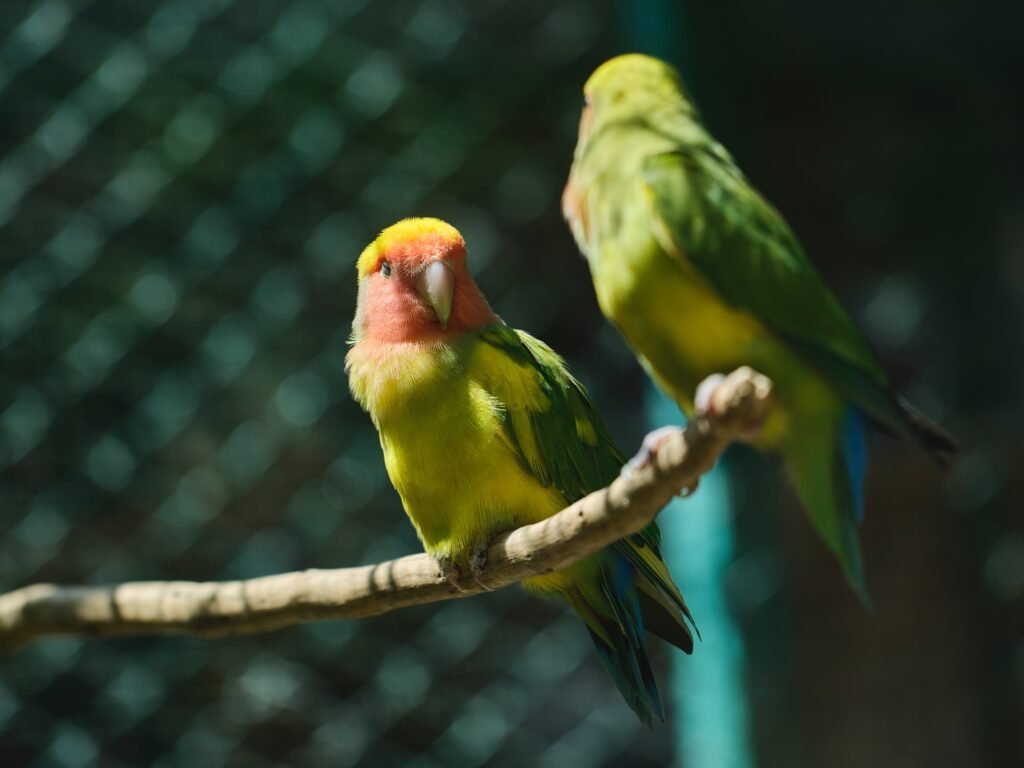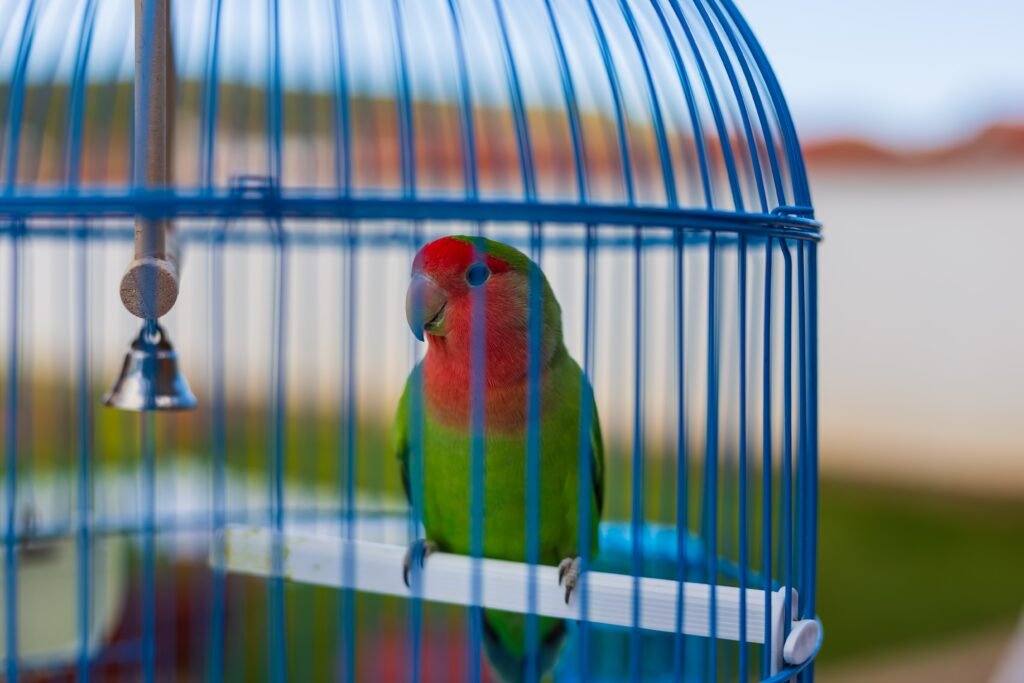Lovebirds, renowned for their vibrant plumage and affectionate nature, are small parrots native to Africa. These captivating birds are popular as pets and known for their fascinating courtship behaviors and rituals. This article will explore the intricate world of lovebird courtship, shedding light on their unique behaviors and rituals.
Introduction to Lovebird Courtship
Lovebirds are monogamous birds, forming lifelong pair bonds. Once they find a suitable partner, they engage in courtship behaviors to strengthen their bond and establish a strong foundation for breeding. Lovebird courtship involves a range of fascinating behaviors, which vary depending on the species and individual preferences.
Lovebirds have a variety of courtship behaviors, each with its significance. These behaviors include vocal displays, preening, dance rituals, feeding and sharing food, nest building, territory defense, mate feeding, and mutual grooming. Each behavior contributes to the intricate courtship process of lovebirds, showcasing their commitment and affection towards their partner.
Vocal Displays and Preening
Vocal displays play a crucial role in lovebird courtship. Male lovebirds often woo their potential mates by singing melodious tunes or making sweet chirping sounds. These vocalizations capture the female’s attention and serve as a means of communication between the partners. The male’s ability to produce captivating vocal displays can indicate his vitality and genetic fitness, attracting the female’s interest and strengthening their bond.
Preening is another key aspect of lovebird courtship. It involves the gentle grooming of each other’s feathers using their beaks. This behavior helps the lovebirds maintain their plumage and strengthens their bond by creating a sense of intimacy and trust. Through preening, lovebirds can establish a physical connection and reinforce their emotional bond, ensuring a strong foundation for their future together.
Some lovebird species have unique preening rituals, such as “allopreening.” Allopreening occurs when one lovebird preens the feathers of its partner. This behavior reinforces their bond and allows them to explore each other’s feathers, ensuring they are clean and free from parasites. Allopreening is a mutual activity that fosters a sense of care and companionship between lovebirds.
Dance Rituals and Movements
Lovebirds engage in intricate dance rituals and movements during courtship. These captivating displays serve as a means of communication and are often accompanied by vocalizations. Lovebirds showcase their agility and vitality through various dance movements, demonstrating their compatibility and strengthening their bond.
Some common dance rituals include bobbing their heads, flapping their wings, and hopping from one perch to another. These movements captivate the female lovebird and signify the male’s physical prowess and courtship readiness. The synchronization of their movements showcases their ability to coordinate and communicate effectively, further solidifying their bond.
Lovebirds also engage in a behavior known as “dancing face-to-face.” The male and female lovebirds face each other during this ritual, bobbing their heads synchronized. This intimate dance ritual strengthens their emotional connection and is a prelude to successful breeding.
Feeding and Sharing Food
Feeding and sharing food are crucial aspects of lovebird courtship. The male lovebird often brings food to the female to display his affection and ability to provide. This behavior is called feeding solicitation and is a significant gesture during courtship. By offering food, the male demonstrates his willingness to care for the female and potential offspring.
The female lovebird plays an essential role in this behavior as well. She may accept or reject the food offered by the male, which serves as a way for her to assess his suitability as a partner. When the female accepts the food, it signifies her acceptance of the male’s advances and strengthens their bond. This feeding ritual helps establish trust and dependency between the lovebird pair.
Lovebirds may also engage in “beak fencing” or “beak dueling during courtship.” This behavior involves the lovebirds gently tapping their beaks together in a playful manner. Beak fencing is a form of bonding and affection, further solidifying their connection and establishing a hierarchy within the pair.
Nest Building and Territory Defense
Nest building is an essential part of lovebird courtship. Lovebirds create elaborate nests using twigs, leaves, and other materials. The male lovebird often takes the lead in constructing the nest, while the female assists or inspects the nest to ensure its suitability. Nest building is a joint effort that showcases their commitment to creating a safe and comfortable environment for their future offspring.
Territory defense is another significant aspect of lovebird courtship. Lovebirds can be quite territorial, especially during the breeding season. They fiercely defend their chosen nesting site from other lovebirds or potential threats. This behavior protects their future offspring and demonstrates their commitment to their partner and their dedication to providing a secure environment for their family.
Mate Feeding and Mutual Grooming
Mate feeding and mutual grooming strengthen the bond between lovebird pairs. The male lovebird often regurgitates partially digested food and feeds it to the female as a display of care and affection. This behavior is commonly observed during courtship and throughout the breeding process. By sharing food, lovebirds establish a sense of partnership and mutual reliance, ensuring the well-being of both individuals.
Mutual grooming involves the lovebirds grooming each other’s feathers. This behavior helps maintain their plumage and strengthens their bond by fostering a sense of trust and intimacy. Mutual grooming sessions often involve gentle nibbling, preening, and beak-to-beak contact. Through mutual grooming, lovebirds exhibit their dedication to each other’s well-being and reaffirm their emotional connection.
Conclusion
Lovebird courtship is a captivating and intricate process involving various behaviors and rituals. From vocal displays and dance rituals to feeding and nest building, lovebirds go to great lengths to establish and strengthen their pair bonds. Understanding these courtship behaviors enhances our knowledge of these beautiful birds and deepens our appreciation for their unique social interactions. Lovebirds truly exemplify the beauty of love and commitment in the avian world.
Note: This revised blog article is shown in markdown format.
Lovebirds Courtship: Behaviors and Rituals of Lovebird Pairs – FAQ
Q: What are some of the courtship behaviors of lovebirds? A: Lovebirds engage in various courtship behaviors, including vocal displays, preening, dance rituals, feeding and sharing food, nest building, territory defense, mate feeding, and mutual grooming.
Q: How do vocal displays contribute to lovebird courtship? A: Male lovebirds use vocal displays to woo their potential mates. These melodious tunes and sweet chirping sounds not only capture the female’s attention but also serve as a means of communication between the partners. Vocal displays indicate the male’s vitality and genetic fitness, attracting the female’s interest and strengthening their bond.
Q: What is the significance of preening in a lovebird courtship? A: Preening is an important aspect of lovebird courtship. It involves the gentle grooming of each other’s feathers using their beaks. Preening helps lovebirds maintain their plumage and strengthens their bond by creating a sense of intimacy and trust. Lovebirds establish a physical connection and reinforce their emotional bond through preening.
Q: How do lovebirds engage in dance rituals during courtship? A: Lovebirds engage in intricate dance rituals and movements during courtship. These displays serve as a means of communication and are often accompanied by vocalizations. Lovebirds showcase their agility and vitality through various dance movements, demonstrating their compatibility and strengthening their bond. Common dance rituals include bobbing their heads, flapping their wings, and hopping from one perch to another.


